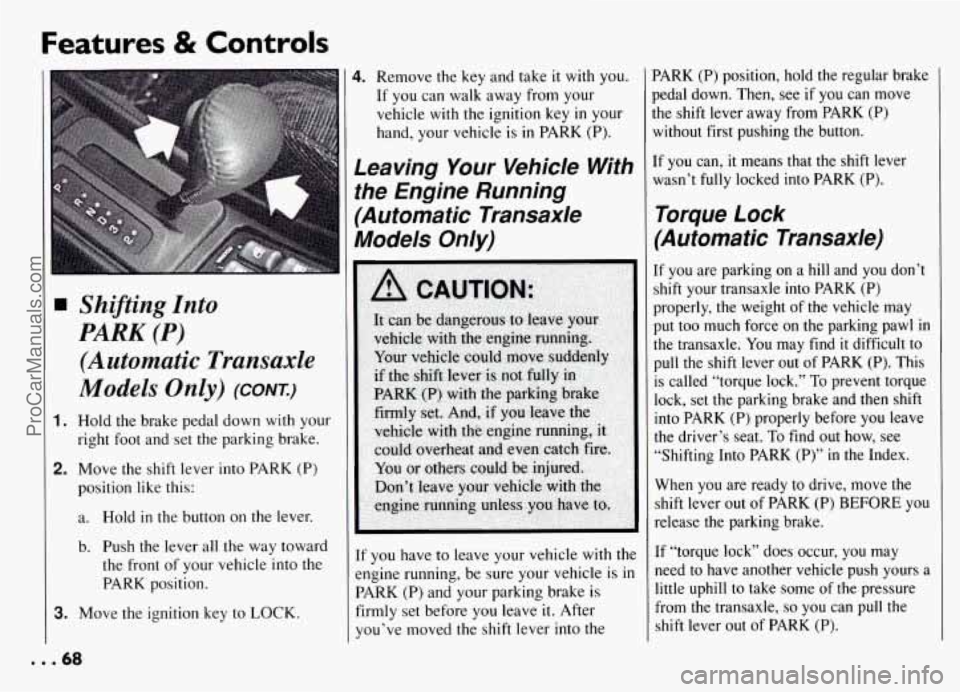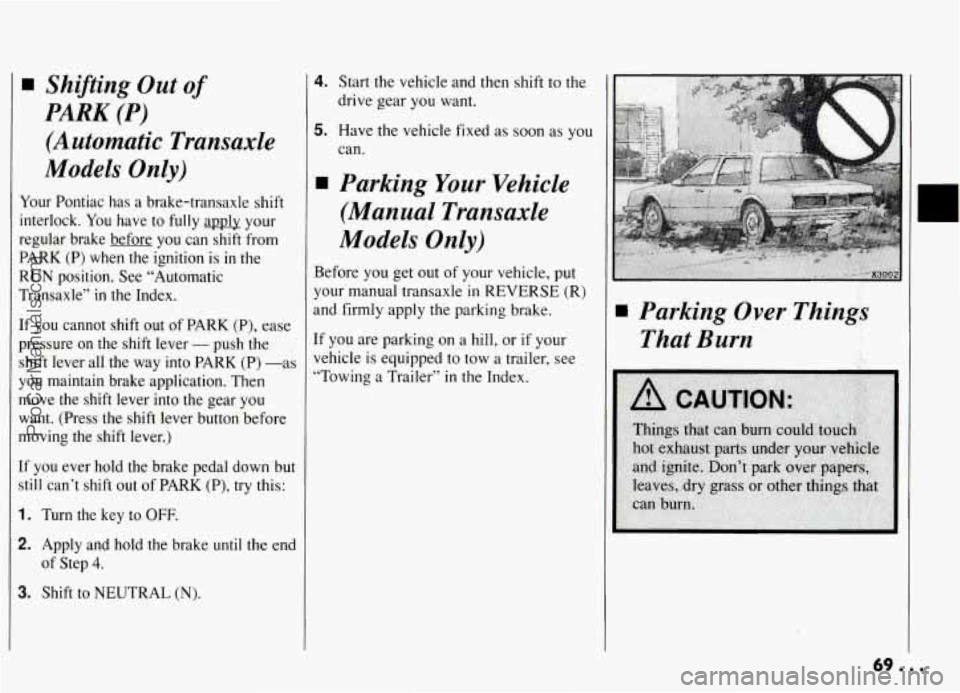Page 56 of 274

LOCK
ACCESSORY
I Ignition Switch-
Vith the ignition key in the ignition
witch, you can
turn the switch ‘to five
ositions:
,CCESSORE An “on” position in
lhich you can operate some of your
lectrical power accessories. Press
in the
;nition switch as you turn the top of
it
)ward you.
,OCK: The only position in which you
!n remove the key. This locks your
:cering wheel, ignition and transaxle
~n automatic models).
IFF: Unlocks the steering wheel,
;nition, and transaxle (on’ automatic
todels), but.does not send electrical
power to any accessories. Use this
position if your vehicle must be pushed or
towed, but never try
to push-start your
vehicle.
A warning’chime will sound if
you open the driver’s door when the
ignition is off and the key is in the
ignition.
RUN: An “on” position to which the
switch returns after you start your engine
and release the switch. The switch stays
in the RUN position when the engine is
running. But ‘even when the engine is not
running, you can use RUN io operate
your electrical power accessories,
and to
display
some instrument panel warning
lights.
START: Starts the engine. When the
engine starts, release the key. The ignition
switch
will return to RUN for normal
driving.
Note that even if the engine is not
running, ‘the positions
ACCESSORY and
RUN are “on” positions that allow you to
operate your electrical accessories, such
as the radio.
,.
Key Release Button
‘MANUAL TRANSAXLE)
The ignition key cannot be removed from
he ignition unless.the key release button
s used.
ro Remwe the Key:
rum the key to the OFF position. Press
he key release button while turning
the
Ley from OFF to LOCK. Keeping your
inger on
the button, pull the key straight
)Ut.
sa...
ProCarManuals.com
Page 57 of 274

Features & Controls
Key Release Button
(MANUAL TRANSAXLE) (CONT.)
NOTICE:
If your key seems stuck in LOCK
and you can’t turn it, be sure it is all
the.way in. If
it is, then turn the
steering wheel left and right while
you
turn the key hard. But turn the
key only
with your hand. Using a
tool to force
it could break the key
or the ignition switch.
If none of this
works, then your vehicle needs
service.
Starting Your Engine
Engines start differently. The 8th digit of
your Vehicle Identification Number (VIN)
shows
the code letter or number for your
engine. You
will find the VIN at the top
left
of your instrument panel. (See
”Vehicle Identification Number”
in the
Index.) Follow the proper steps to start
the engine.
Automatic transaxle
Move your shift lever to PARK (P) or
NEUTRAL (N). Your engine won’t start
in any other position -- that’s a safety
feature. To restart when you’re already
.EUTRAL (N) only.
Don’t try to shift to PARK (P) if
your Pontiac is moving. If you do,
you could damage the transaxle.
Shift to PARK (P) only when your
vehicle
is stopped.
Manual transaxle
Hold the clutch pedal to the floor, then
shift your gear selector to neutral while
starting the engine. Your vehicle won’t
start
if the clutch pedal is not all the way
down
-- that’s a safety feature.
Both Transaxles
To Start Your 2.3 Liter EnEine
(Codes
3. D or A):
1. Without pushing the accelerator pedal,
turn your ignition key to START.
When the engine starts, let
go of the
key. The idle speed
will go down as
your engine gets warm.
NOTICE:
Holding your key in START for
longer than
15 seconds at a time will
cause your battery to be drained
much sooner. And the excessive
heat can damage your starter motor.
ProCarManuals.com
Page 59 of 274

Features & Controls
Bofh Transaxles (CONT.)
NOTICE:
Your engine is designed to work
with the electronics
in your vehicle.
If you add electrical parts or accessories, you could change the
way the fuel injection system
operates. Before adding electrical
equipment, check
with your dealer.
If you don’t, your engine might not
perform properly.
If you ever have to have your
vehicle towed, see the part of this
manual that
tells how to do it
without damaging your vehicle. See
“Towing Your Pontiac”
in the
Index.
Driving Through Deep
Standing Water
NOTICE:
If you drive too quickly through
deep puddles or standing water,
water can come in through your
engine’s air intake and badly
damage your engine. If you can’t
avoid deep puddles or standing
water, drive through them very
slowly.
I Engine Coolant Heater (Engine
Block Heater)
(OPTION)
[n very cold weather, 0°F (- 18°C) or
;older, the engine coolant heater can help.
You’ll get easier starting and better fuel
zconomy during engine warm-up.
Usually, the coolant heater should be
plugged.
in a minimum of four hours prior
to starting your vehicle.
To Use the Coolant Heater:
1. Turn off the engine.
2. Open the hood and unwrap the
electrical cord.
... 58
ProCarManuals.com
Page 61 of 274
Features & Controls
Three Speed Automatic
Four Speed Automatic
I
Park
PARK (P): This locks your front wheels
[t’s the best position to use when
you sta
your engine because your vehicle can’t
move easily.
... 60
ProCarManuals.com
Page 62 of 274

Ensure the shift lever is fully in PARK (P)
range before starting the engine. Your
Pontiac has a brake-transaxle shift
interlock.
You have to fully apply your
regular brake before you can shift from
PARK (P) when the ignition key is in the
RUN position. If you cannot shift out of
PARK (P), ease pressure on
the shift
lever- push the shift lever all the way
into PARK (P)
- as you maintain brake
application. Then move
the shift lever
into the gear you wish. (Press the shift
lever button before moving the shift
lever.) See “Shifting
Out of PARK (P)”
later
in this section.
I
Reverse
REVERSE (R): Use this gear to back up.
NOTICE:
Shifting to REVERSE (R) while
your vehicle is moving forward
could damage your transaxle. Shift
to REVERSE only after your
vehicle is stopped.
To rock your vehicle back and forth to get
out of snow, ice or sand without
damaging your transaxle, see “If You’re
Stuck: In Sand, Mud, Ice or Snow” in the
Index.
Neutral
NEUTRAL (N): In this position,,your
engine doesn’t connect with the wheels.
To restart when you’re already moving,
use NEUTRAL
(N) only. Also, use
NEUTRAL when your vehicle is Geing
towed.
61 ...
ProCarManuals.com
Page 69 of 274

Features & Controls
T
Shifting Into
PARK (P)
(Automatic Transaxle
Models Only) (cow)
1. Hold the brake pedal down with your
right foot and set the parking brake.
2. Move the shift lever into PARK (P)
position like this:
a. Hold
in the button on the lever.
b.
Push the lever all the way toward
the front of your vehicle into the
PARK position.
3. Move the ignition key to LOCK.
4. Remove the key and take it with you.
If you can walk away from your
vehicle
with the ignition key in your
hand, your vehicle
is in PARK (P).
Leaving Your Vehicle With
the Engine Running
(Automatic Transaxle
Models Only)
If you have to leave your vehicle with the
engine running, be sure your vehicle is
in
PARK (P) and your parking brake is
firmly set before you leave it. After
you’ve moved the shift lever into the
’ARK (P) position, hold the regular brake
Jedal down. Then, see
if you can move
he shift lever away from
PARK (P)
without first pushing the button.
:f you can, it means that the shift lever
wasn’t
fully locked into PARK (P).
Torque Lock
(Automatic Transaxle)
[f you are parking on a hill and you don’t
shift your transaxle into PARK (P)
properly, the weight of the vehicle may
put too much force on the parking pawl
in
[he transaxle. You may find it difficult to
pull the shift lever out of PARK (P). This
is called “torque lock.” To prevent torque
lock, set the parking brake and then shift
into
PARK (P) properly before you leave
the driver’s seat.
To find out how, see
”Shifting Into
PARK (P)” in the Index.
When you are ready to drive, move the
shift lever out of PARK (P) BEFORE you
release the parking brake.
If “torque lock” does occur, you may
need to have another vehicle push yours a
little uphill to take some of the pressure
from the transaxle,
so you can pull the
shift lever out of
PARK (P).
... 68
ProCarManuals.com
Page 70 of 274

H Shifting Out of
PARK (P)
(Automatic Transaxle
Models Only)
Your Pontiac has a brake-transaxle shift
interlock. You have to
fully apply your
regular brake before you can shift from
PARK
(P) when the ignition is in the
RUN position. See “Automatic
Transaxle”
in the Index.
tf you cannot shift out of PARK (P), ease
pressure on the shift lever
- push the
shift lever all the way into PARK (P) -as
you maintain brake application. Then
move the shift lever into the gear you
want. (Press the
shift lever button before
moving the shift lever.)
[f you ever hold the brake pedal down but
still can’t shift out of PARK (P), try this:
1. Turn the key to OFF.
2. Apply and hold the brake until the end
of Step 4.
3. Shift to NEUTRAL (N).
4. Start the vehicle and then shift to the
drive gear you want.
5. Have the vehicle fixed as soon as you
can.
Parking Your Vehicle
(Manual Transaxle
Models Only)
Before you get out of your vehicle, put
your manual transaxle
in REVERSE (R)
and firmly apply the parking brake.
If you are parking on a hill, or if your
vehicle is equipped to tow a trailer, see
“Towing a Trailer”
in the Index.
Parking Over Things
That Burn
ProCarManuals.com
Page 72 of 274
Follow the proper steps to be sure your
vehicle won’t move. See “Shifting Into
PARK (P)” in the Index.
If you’re pulling a trailer, see “Towing a
Trailer”
in the Index.
Horn
You can sound the horn by pressing the
horn symbol
on your steering wheel.
A tilt steering wheel allows you to adjust
the steering wheel before you drive.
You can also raise it to the highest level tc
give your legs more room when you exit
and enter the vehicle.
To tilt the wheel, hold the steering wheel
and pull the lever. Move the steering
wheel to a comfortable level, then release
the lever
to lock the wheel in place,
71 ...
ProCarManuals.com